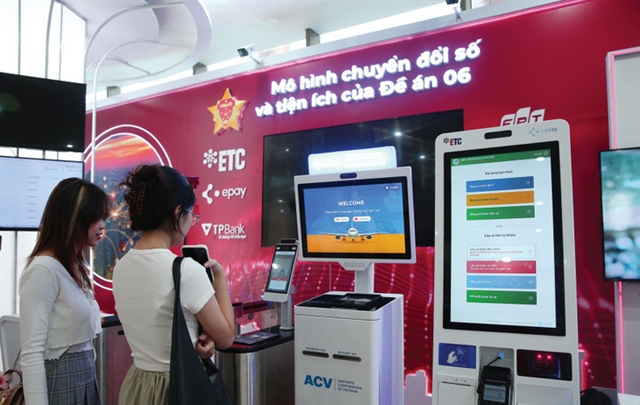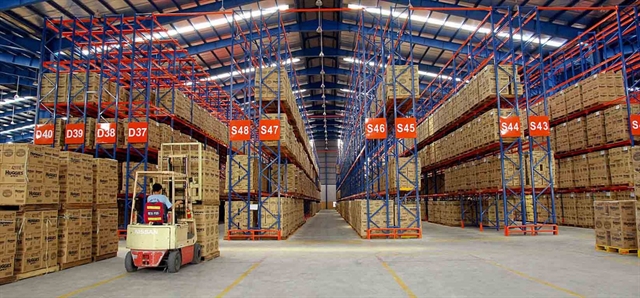 Business Beat
Business Beat


|
| A warehouse in HCM City. Photo baytoancau.com.vn |
Compiled by Thiên Lý
In May Singapore’s Emergent Việt Nam Logistics Development Pte. Ltd. was licensed to develop the US$34.4 million Logistics ECPVN Bình Dương 2 Centre.
The facility at the Tân Đông Hiệp B Industrial Park, when completed, will offer logistics, storage and warehousing services.
Another Singaporean company, Frasers Property, a developer of residential, commercial and industrial properties in Việt Nam, plans to develop its Bình Dương Industrial park into an industrial and logistics complex focusing on distribution and light, supporting and hi-tech industries.
Also in May ESR Cayman Limited and BW Industry Development Joint Stock Company entered into a joint venture for a project at Bình Dương Province’s Mỹ Phước 4 Industrial Park.
It will provide services for logistics and light industrial activities.
Denmark’s A.P. Moller- Maersk decided to strengthen its contract logistics and distribution capabilities in Việt Nam by opening two new facilities in Bình Dương and another in the northern province of Bắc Ninh, creating an additional 38,000 square meters of warehousing space in addition to its current 11 self-managed facilities in the country.
In addition to directly investing in the Vietnamese logistics industry, foreign investors are also tying up with the local industry.
Start-up EcoTruck, established in 2017, recently received $2 million from South Korean fund STIC Ventures. The money will be used for expanding operations using technology.
EcoTruck has over 300 partners with 9,000 vehicles serving 500 customers across the country and abroad.
Market observers said in the first five months of this year logistics property projects accounted for a large proportion of FDI projects licensed.
Domestic companies have also been active.
In 2020 EcoTruck had raised more than VNĐ100 billion from a group of local investors led by internet and technology giant VNG Corporation.
Nhất Tin Investment Development Joint Stock Company (Nhất Tín Logistics) has developed around 100,000 square metres of warehouses across the country including Văn Giang Warehouse in the northern province of Hưng Yên and Sóng Thần Warehouse in the southern province of Bình Dương.
Several acquisition deals have been announced recently in the sector, one of which is Dương Minh Logistics, which received $15 million from an undisclosed investor through an M&A deal.
Provincial and city governments too have entered the race with logistics infrastructure development plans. Among them are Hà Tĩnh, Đồng Nai, Vũng Tàu, Hậu Giang, Đà Nẵng, HCM City and Cần Thơ.
Hà Tĩnh, for instance, has approved a detailed plan to build a 133ha logistics centre in Vũng Áng District.
HCM City has approved an ambitious logistics development plan for 2021-30 under which 7 logistics centres with around 623 hectares of space to be used for storage, order picking and distribution of goods will be built.
The Cửu Long (Mekong) River Delta Province of Hậu Giang has announced plans to develop three logistics centres by 2025.
Bùi Trang, senior director of markets at property consultant Jones Lang LaSalle Vietnam, said in the last two years nearly $3 billion had been invested in warehousing and logistics.
Why has the sector become so attractive to both domestic and foreign investors?
Marco Civardi, managing director of Maersk Việt Nam, Campuchia and Myanmar, said warehousing demand has increased sharply for foreign trade during the Covid-19 pandemic due to a severe shortage of vessels and containers.
Nguyễn Thị Vũ Anh, director of Gaw NP Industrial, said supply of logistics facilities including warehousing space and ready-built workshops is unable to meet demand.
Civardi said another very important reason is the rapid growth in e-commerce and door-to-door delivery services.
Analysts said warehouse logistics play a very important role in the e-commerce industry.
A global report by Savills says the boom in e-commerce, especially amid the COVID pandemic has boosted warehousing demand in many markets around the world including Việt Nam.
Low operating cost is another reason for warehouse expansion in Việt Nam.
The Savills report, made last March, says warehousing property costs are highest in major world cities with large populations and little land supply, with four markets standing above the rest: London, Tokyo, Hong Kong, and Singapore. All have costs well above $20 per sq ft.
Very low labour costs coupled with extremely low energy costs make Việt Nam the cheapest location, led by Hà Nội, according to the report.
In Hà Nội the average cost per square foot of warehouse space is around $5, and in HCM City it is less than $10.
These low costs make Việt Nam highly attractive to multinationals, but the Government is actively targeting companies with enormous potential.
According to the Việt Nam E-commerce Association, the country’s e-commerce growth in recent years has averaged 18 per cent a year and the rate is expected to continue until 2025.
According to the Việt Nam Logistics Association the industry is growing at an annual rate of 14-16 per cent and is worth $40-42 billion now.
Trần Ngọc Thái Sơn, general director of Tiki, said e-commerce in HCMC, the country’s biggest economic hub, was growing at two or three times the country’s average rate.
Demand for ecommerce had increased significantly during the pandemic, he said.
Analysts say despite the strong investment flows they have attracted, logistics properties in Việt Nam are in the early stage of development, and the industry still has much room for growth.
They point to the fact that logistics space per capita in Việt Nam is much lower than in many other countries at a 30th of the US’s and a third of China’s.
IT application in logistics
Analysts say the logistics market, especially logistics properties, in Việt Nam has great potential but also faces some hurdles that need to be removed for it to fully develop.
The country lacks logistics enterprises with modern equipment and large distribution networks.
Some have in recent years made an effort to modernise their operations to meet the rising demand from ecommerce, but the transformation has not been as quick as expected.
The two biggest obstacles facing the industry are a shortage of resources and high costs except warehousing, analysts say.
They say however these could be resolved by adopting advanced technologies.
Normally, a worker can handle a maximum of 100-200 orders per hour but IT helps increase that to hundreds of thousands of orders.
IT, automation and artificial intelligence also help control goods, divide and select them better based on encoded dates and minimise manual work.
Lê Mạnh Cường, chairman of Lokaloop Company, said the Government acknowledged the importance of IT in logistics supply chains and strongly encouraged IT use.
Many logistics businesses, especially start-ups, are using advanced technologies to create convenient and efficient systems at low costs. VNS




